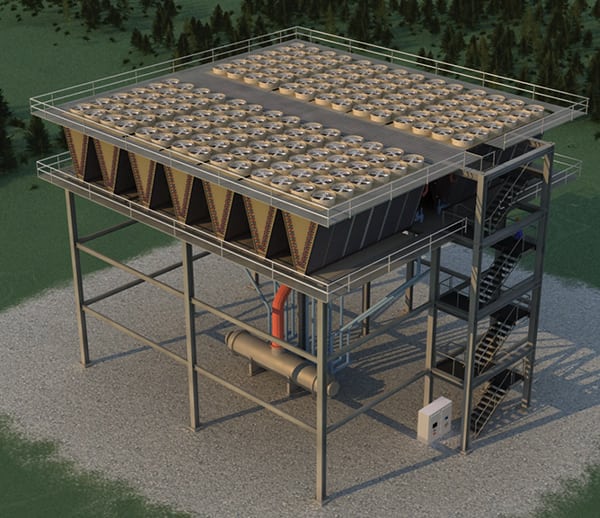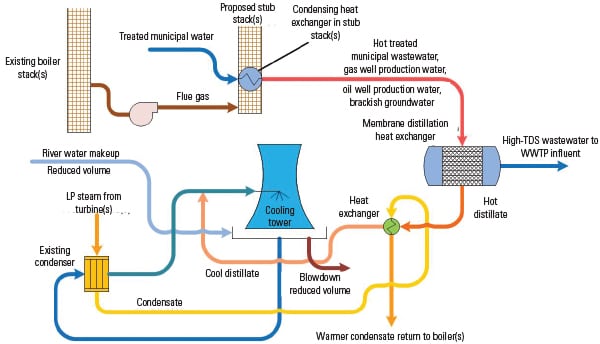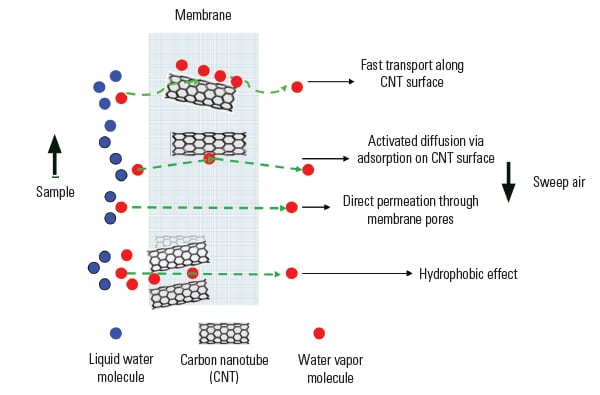Worldwide awareness of the need to minimize freshwater use for power generation—while minimizing energy penalties—is growing. The Electric Power Research Institute is involved in several programs that are developing innovative technologies.
Technology development to reduce freshwater withdrawals and consumption for all types of thermoelectric power plants is emerging as a top research and development (R&D) priority. Thermoelectric plants in the U.S. account for approximately 40% of the nation’s total freshwater withdrawals and approximately 3% of overall consumption—due primarily to evaporative and blowdown losses from cooling systems with wet cooling towers.
These freshwater use rates at plants using current technologies might not be sustainable in some locations. Already, some plants operate under water use restrictions or are installing water-conserving technologies. Furthermore, the siting of new capacity is challenged by water supply constraints.
As a result, the Electric Power Research Institute (EPRI) and other research organizations worldwide are seeking to develop technologies with high potential for significant water consumption reductions, such as advanced cooling technologies and those that enable the use of degraded water sources.
Advanced R&D Areas
Research and development on advanced cooling technologies for power plants focuses on several targets. For wet cooling systems, research is aimed at reducing evaporative loss in cooling towers and advancing hybrid wet-dry cooling systems. For dry cooling systems, research is aimed at reducing steam condensation temperature by improving the air side heat transfer coefficient without significantly increasing fan power consumption or the size of air-cooled condensers, and by developing alternative dry cooling technologies.
In this arena, EPRI is pursuing early-stage, high-risk concepts and developing advanced technologies with game-changing potential for reducing freshwater withdrawal and consumption while improving energy conversion efficiency at existing power plants.
Since 2011, EPRI has released three global request for information solicitations and conducted innovation scouting to help identify ideas with breakthrough potential. Among the 168 proposals received to date, 12 projects involving wet, dry, and hybrid cooling technologies are under way, and eight more projects will soon be started.
Some of the technologies under development are described below.
Advanced Cooling Technologies
The following three advanced cooling technologies take different approaches to the challenge of making water use more efficient. The thermosyphon cooler system has made the furthest progress to date through EPRI’s technology development pipeline, having nearly completed in-plant pilot testing.
Thermosyphon Cooler System. Hybrid cooling systems typically incorporate conventional wet cooling towers and air-cooled condensers, with the latter operating the majority of the time and the former employed to mitigate performance penalties at high ambient temperatures. A novel hybridization concept, developed by Johnson Controls, applies a dry-heat-rejection technology, called a thermosyphon cooler (TSC), originally developed for reducing water use associated with chillers used in building space conditioning (Figure 1). TSC units, consisting of an evaporator, an air-cooled condenser, and controls, sensibly precool the hot water from the steam condenser prior to the wet cooling tower.
By reducing the heat load on the cooling tower, TSC hybrid systems have the potential to lower annual evaporative losses, makeup water requirements, and blowdown volumes for thermoelectric power plants by up to 75%—without sacrificing output on the hottest summer days.
Relative to other dry cooling options, TSC technology promises easier, more flexible, lower-cost integration at existing plants and in new builds in incremental, modular sections, with minimal plant outages required.
Ongoing design and modeling research is addressing issues of scale-up, cooling tower integration, and cost and performance relative to other cooling configurations for conceptual 500-MW plants at five locations with differing climates.
A pilot-scale system incorporating a 1-MW equivalent TSC unit and pilot cooling tower is also under test at the Water Research Center, an EPRI/Georgia Power collaborative effort located at Plant Bowen. That project will determine how much water can be saved by operating a TSC unit in series with a conventional wet cooling tower. Researchers also will determine the energy penalty incurred and the most effective means for scale-up. In 2014, the possibility of a field validation of a 16-MW thermosyphon cooler module optimized for retrofit applications will be explored.
Dew-Point Cooling Tower. Traditional cooling towers can only approach the wet-bulb temperature of ambient air for their cold water return temperature. EPRI, in collaboration with the Gas Technology Institute, is investigating a concept called dew-point cooling to attempt to lower this temperature further. This technology enhances the standard tower performance by constructing dry channels between wet channels in the tower fill with a thin-walled fill material and exploiting evaporative cooling on the wet side of the fill to cool the ambient air passing over the dry side. This precooled air is then used for contact evaporative cooling with the condenser water (Figure 2).
Dew-point cooling offers the potential to improve the water efficiency and productivity of steam-electric plants with conventional wet and hybrid wet-dry cooling towers. Preliminary evaluations indicate that tower fill replacements that allow the precooling of ambient air could reduce evaporative losses and makeup water requirements at existing plants sited in arid regions while lowering the temperature of cooled water.
Design development and proof-of-concept modeling initiated in 2012 focused on optimizing the fill configuration to maximize the precooling of incoming air in dry channels and to reduce evaporative losses. In 2013, EPRI conducted experimental proof-of-concept studies on a test section of cooling tower fill to quantify potential water savings. Engineering and economic modeling for a representative 500-MW coal-fired plant assessed water and energy impacts across a range of ambient conditions, investigated system integration issues, and compared cost and performance with conventional cooling tower fill for both retrofit and new construction applications. In 2014, a section of dew-point cooling tower fill engineered to provide 0.1 MW of cooling will undergo testing at an industry-certified facility.
Hybrid Dry/Wet Dephlegmator. One of the chief disadvantages of dry cooling systems is capacity reductions and efficiency penalties during periods with hot temperatures. EPRI is sponsoring research at the University of Stellenbosch in South Africa to address this issue. The research is developing a new design for the part of an air-cooled condenser (ACC) called the dephlegmator (Figure 3). In ACCs, the dephlegmator provides a secondary condenser that facilitates vapor flow through the primary condensers, flushing them of any noncondensable gases.
 |
| 3. New design for familiar part. The hybrid dry/wet dephlegmator shown here adds a dry/wet second stage to the traditional dry first stage. Source: University of Stellenbosch |
This research project proposes to develop a novel hybrid (dry/wet) dephlegmator (HDWD), which would replace the conventional all-dry dephlegmator unit in an ACC. The HDWD consists of two stages. A dry first stage is an ACC with inclined finned tubes, similar to those in a conventional A-frame configuration. The dry/wet second stage consists of a near-horizontal, dry/wet heat exchanger.
The operating mode of the second stage can be controlled in response to changing ambient conditions. During periods of low ambient temperature, when air cooling is sufficient, the second stage is operated dry. During hotter periods, deluge water is sprayed over the plain tubes, and the second stage is operated as an evaporative condenser.
This technology has the potential to increase power production on the hottest days as compared to conventional ACCs. It would also use less makeup water than wet cooling tower systems and less water than currently is used by dry cooling with the aid of evaporative precooling of the inlet air.
This EPRI project aims to further develop the design concept, perform modeling and experimental investigations of various options, and conduct technical and economic feasibility studies.
Using Degrading Water Sources
Several projects are also studying advanced water treatment technologies to enable the use of degraded water sources for cooling systems—something that is of increasing interest (out of necessity) worldwide.
Membrane Distillation/Degraded Water Source. EPRI is collaborating with Sandia National Laboratories and WEN Engineering to evaluate the feasibility of integrating membrane distillation water treatment technology into cooling tower systems to treat unconventional types of water that could serve as alternatives to freshwater for makeup water.
Membrane distillation (MD) technology uses latent energy from waste heat to drive a membrane separation process that removes salts and other total dissolved solids from an unconventional water type such as brackish groundwater or seawater (Figure 4). By using waste heat sources at a power plant, MD could desalinate water without added energy costs, representing a new low-cost method to treat brackish groundwater for makeup water.
MD technology may represent an innovation that allows many power plants in semi-arid areas to maintain full utilization of wet-cooling systems by using alternative sources of water.
Current research will assess the economic feasibility of integrating MD water treatment technology into wet cooling tower technology. Economic modeling is being conducted on selected coal power plants in Arizona, Texas, and Kentucky. Integration of MD into wet cooling tower technology has the potential to reduce freshwater requirements from 30% to 100%. Economic analysis will also evaluate a combined wet cooling plus MD system versus a dry cooling system.
Although freshwater acquisition costs vary by geographical region, arid and semi-arid areas will likely benefit most from the new technology. The economic model will establish a range of freshwater acquisition that makes MD/cooling tower integration feasible.
Carbon Nanotube–Enabled Membrane Distillation. Carbon nanotube immobilized membranes (CNIM) could enable the generation of pure water from saline and brackish water, as well as support the use of degraded water sources for power plant cooling.
EPRI and the New Jersey Institute of Technology are researching the use of carbon nanotubes (CNTs) to create breakthrough membrane properties for generating pure water via membrane distillation (Figure 5). As noted above, MD is a membrane-based thermal evaporative process that operates at relatively low temperatures (50C to 90C); as such, it is particularly attractive for producing high-purity water in power plants where waste heat is available in the form of boiler blowdowns, flue gases, and low-pressure steam.
This fundamentally new approach could reduce the cost and energy requirements for using waste and brackish water in power plants and could change the competitive landscape of conventional methods such as reverse osmosis (RO) and thermal evaporation.
In addition to being an enabling technology for the use of alternative water sources for cooling, CNIM-MD would also allow cooling towers to operate at higher cycles of concentration by treating highly saline cooling tower effluent. CNIM-MD can be implemented by itself to replace RO, or the effluent from RO can be used as the feed to CNIM-MD for increasing overall recovery. The effluent from CNIM-MD can be used as boiler feedwater with minimal or no further treatment and also for other high-quality water required in power plants.
CNIM-MD can also potentially replace evaporators, or the high-ionic-strength effluent from MD can be used to reduce the load on the evaporators and crystallizers. CNIM-MD can move power plants towards “zero liquid discharge.”
Reverse Osmosis Advanced Membrane Monitoring. EPRI is collaborating with the University of California, Los Angeles (UCLA) Water Technology Research Center to develop and demonstrate a novel RO operational paradigm for treating cooling tower blowdown (CTB) water. Building on a UCLA-patented membrane monitor (MeMo), the technology could recover up to 80% of CTB for reuse.
In the electric power sector, significant interests have emerged regarding the use of RO technologies for the treatment of CTB wastewater and reuse as cooling tower makeup water or other beneficial uses (such as boiler feed). Although RO is a relatively mature technology, its application for treatment of CTB water for on-site reuse (including cooling water makeup) remains a challenge due to membrane mineral scaling, which leads to water permeate flux decline and potential membrane damage.
Direct, real-time mineral scale monitoring using MeMo will enable RO plants to operate self-adaptively near the maximum water recovery levels while maintaining operational reliability in mitigating mineral scaling. In addition, automated “self-cleaning” via cyclic mode of feed flow or other cleaning methods, triggered by MeMo, can potentially eliminate or reduce antiscalant use and thus reduce operational costs (Figure 6).
Application of the MeMo-Feed Flow Reversal (FFR) technology in RO plants for cooling tower water treatment would enable RO operation at optimal water recovery levels, improve plant operational reliability and robustness (with respect to changing feedwater quality), and thus reduce membrane cleaning frequency and their associated costs. In some applications, a MeMo-FFR operational strategy may potentially eliminate or reduce antiscalant usage, thereby reducing operational costs.
EPRI research is funding further development and testing of the MeMo-FFR concept for recovering cooling tower blowdown water for reuse. EPRI also is providing expertise to evaluate the technology’s overall feasibility, supporting codes and standard studies, and providing guidance for estimating the economics of MeMo deployment, including in a MeMo-FFR process.
Future Opportunities for Collaboration with EPRI
Several of these technologies are anticipated to successfully complete pilot scale level testing in the next six months to two years, after which they would be ready for large-scale demonstration—the final step before commercialization.
A major focal point for future research is a new Water Research Center (WRC) at Georgia Power’s Plant Bowen, a 3,500-MW coal-fired plant. This first-of-its-kind, industry-wide resource offers a pilot-scale infrastructure for conducting scaled-up, plant-based water research. The WRC provides electric generating companies, research organizations, and vendors with access to a field demonstration facility that has treatable water, monitoring and analysis facilities, and specialist staff. Research conducted at the WRC may help develop insights on best practices for sustainable water management and meeting wastewater restrictions.
In addition, EPRI and the National Science Foundation recently released a joint solicitation to advance dry cooling and dry-wet hybrid cooling technologies for power plant applications. Continuing power plant integration studies will quantify water savings and compare cost and performance with conventional cooling systems across a range of ambient conditions.
This project is a $6 million joint collaboration, which aims to engage some of the world’s leading researchers in the development of power plant cooling innovations and to fund five to 10 projects. Award notifications will be announced in early 2014 and may include R&D on novel air-cooled condenser advancements, high-efficiency adsorption chiller technology, and advanced indirect dry cooling tower design. ■
— Sean Bushart (sbushart@epri.com) is director, generation environmental sciences, at EPRI; Jessica Shi (jshi@epri.com) is senior technical leader/manager for technology innovation research for cooling and water treatment technologies at EPRI.




